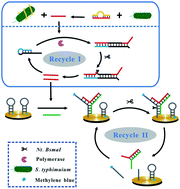Two-stage nicking enzyme signal amplification (NESA)-based biosensing platform for the ultrasensitive electrochemical detection of pathogenic bacteria
Abstract
The sensitive and selective detection of pathogenic bacteria represents an essential approach in food safety analysis and clinical diagnostics. We report the development of a simple, rapid, and low-cost electrochemical biosensing strategy for the detection of pathogenic bacteria with ultrasensitivity and high specificity. The biosensor relies on the target and aptamer binding-triggered two-stage nicking enzyme signal amplification (NESA) and three-way junction probe-mediated electrochemical signal transduction. In the presence of the target S. typhimurium, the specific binding of S. typhimurium and aptamer results in the release of a primer, which hybridizes with HAP1 and initiates an extension reaction with the aid of polymerase and dNTPs. A specific recognition site for Nt.BsmaI is generated in the DNA duplex; thus, the produced DNA is nicked and the secondary primer is released (named recycle I). Subsequently, the reaction solution supplemented with a helper DNA is dropped on the electrode surface, and a three-way junction probe containing a specific recognition site for Nt.BsmaI is thus formed. The MB-labeled probe is nicked with the help of Nt.BsmaI and the dissociated primer-helper DNA duplex combines with another HAP2 (named recycle II). Thus, a remarkably decreased electrochemical signal is generated because the electroactive MB is far away from the electrode surface. As far as we know, this work is the first time that NESA and three-way junction probe-mediated electrochemical signal transduction has been used for pathogenic bacteria detection. Under optimal conditions, the results reveal that the calibration plot obtained for S. typhimurium is approximately linear from 9.6 to 9.6 × 105 cfu mL−1 with the limit of detection of 8 cfu mL−1. Additionally, the proposed strategy has been successfully applied to the quantitative assay of S. typhimurium in the real samples. Therefore, the NESA-based biosensing strategy might create a useful and practical platform for pathogenic bacteria identification, and the related food safety analysis and clinical diagnosis.

- This article is part of the themed collection: Analytical Methods HOT Articles 2022


 Please wait while we load your content...
Please wait while we load your content...